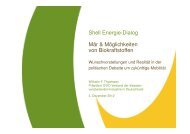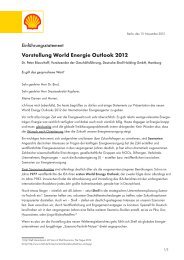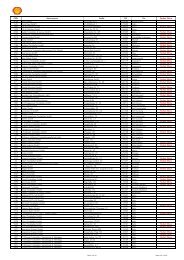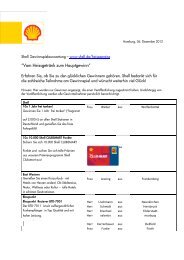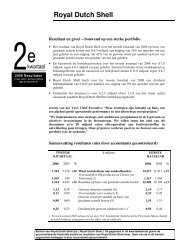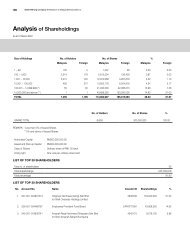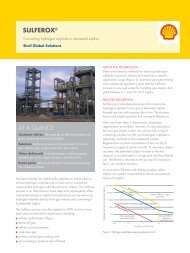ENVIRONMENTAL STATEMENT BARDOLINO DEVELOPMENT
ENVIRONMENTAL STATEMENT BARDOLINO DEVELOPMENT
ENVIRONMENTAL STATEMENT BARDOLINO DEVELOPMENT
You also want an ePaper? Increase the reach of your titles
YUMPU automatically turns print PDFs into web optimized ePapers that Google loves.
Bardolino Development Environmental Statement<br />
Activity / Source of<br />
Potential Impact<br />
1. Well Engineering, continued<br />
1.6 Gaseous emissions<br />
from well clean-up and<br />
testing<br />
1.7 Gaseous emissions<br />
from power generation<br />
on drilling rig or vessels<br />
1.8 Discharge to sea<br />
of drainage water or<br />
sewage from the<br />
drilling rig<br />
Possible Environmental Effects Prevention, Control & Mitigation Measures<br />
• The combustion of reservoir fluids flowed<br />
during clean-up for each well would<br />
release gaseous emissions to the<br />
atmosphere. These could contribute to<br />
global processes such as global warming,<br />
acid rain deposition and low level ozone<br />
formation (cumulative and trans-boundary<br />
effects).<br />
• The burning of diesel fuel on the drilling<br />
rig and support vessels would release<br />
gaseous emissions to atmosphere.<br />
• This could lead to deterioration in air<br />
quality in the immediate vicinity of the<br />
exhaust outlets.<br />
• Gaseous emissions could also contribute<br />
to global processes such as global<br />
warming, acid deposition and low-level<br />
ozone formation (cumulative and transboundary<br />
impacts).<br />
• The discharge of cleaned oily drainage<br />
water from the rig’s machinery space<br />
drainage system would introduce oil into<br />
the sea.<br />
• The discharge to sea of macerated<br />
sewage from the rig’s domestic sewage<br />
system, would cause localized organic<br />
enrichment in the vicinity of the discharge<br />
location.<br />
• The well clean-up procedures would aim to<br />
minimise the amount of product flowed. It is<br />
planned that each combined clean-up and welltest<br />
would take no longer than 48 hours at a<br />
maximum of 15,000 bbl of oil with an expected<br />
GOR of 870 scf/bbl.<br />
• No extended well test or clean-up is planned<br />
and it is likely that the quantities flared will be<br />
no more that 8,000 bbls.<br />
• Highly efficient flare burners would be used, to<br />
minimise drop-out and reduce the formation of<br />
black smoke.<br />
• All engines, generators and other combustion<br />
plant would be well maintained and correctly<br />
operated, to ensure that they were working as<br />
efficiently as possible to minimise emissions.<br />
• There would be systems in place on the rig to<br />
ensure that drainage discharges complied with<br />
MARPOL. This requires that the rig must be<br />
fitted with oil-water separation and filtration<br />
equipment, to ensure that the concentration of<br />
oil in any discharged water is less than 15ppm.<br />
• The rig would have UK or International Oil<br />
Pollution Prevention certification for its drainage<br />
systems.<br />
• Sewage would be macerated on the rig to aid<br />
biological breakdown once discharged into the<br />
sea.<br />
• Significance Rating (refer Table 5.3<br />
Page 5-8 April 2008<br />
for key)<br />
Moderate – See Section 6<br />
• In the exposed and generally windy conditions offshore,<br />
the gaseous emissions would disperse rapidly after<br />
release, thus ensuring there was no local cumulative<br />
effect.<br />
• The emissions from well clean-up and testing would make<br />
a very small contribution to world-wide levels of<br />
atmospheric contaminants, when compared to other<br />
industrial sources.<br />
Minor – See Section 6<br />
• In the exposed and generally windy conditions offshore,<br />
the gaseous emissions would disperse rapidly after<br />
release, thus ensuring there was no local cumulative<br />
effect.<br />
• The gaseous emissions that would arise from power<br />
generation processes on the drilling rig and associated<br />
vessels would make a very small contribution to worldwide<br />
levels of atmospheric contaminants, when compared<br />
to other industrial sources.<br />
Minor<br />
• Only small volumes of drainage water would be<br />
discharged from the rig’s machinery space, and the<br />
concentration of oil would be low.<br />
• In the generally energetic conditions offshore in the North<br />
Sea, such small volumes of water would be rapidly<br />
dispersed and diluted.<br />
• At the offshore location, the small volumes of macerated<br />
sewage would be rapidly dispersed in the water column<br />
and be insignificant in terms of organic enrichment.


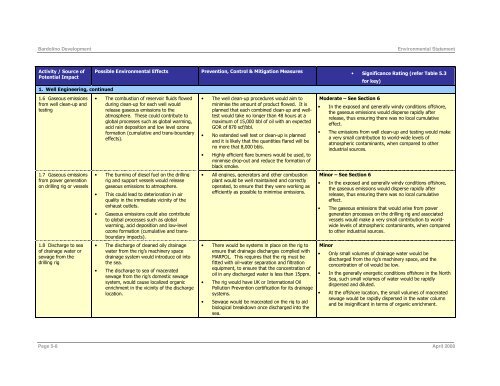
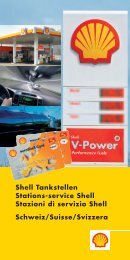
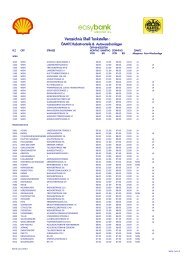
![Download Shell AutoGas Stationen [Stand: Januar 2013] (PDF](https://img.yumpu.com/9982753/1/190x245/download-shell-autogas-stationen-stand-januar-2013-pdf.jpg?quality=85)
